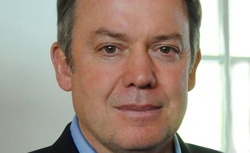Questions for Michael Crow
The president of Arizona State University talks about academic bureaucracy, tenure, and ASU's unusual admissions policy.
How do you get people to rethink old systems and habits? In academia, we become entrenched in obsolete organizational models and social constructs. There's the traditional model that was established by schools like Harvard and Yale and Michigan and Berkeley, and all of our colleges and universities strive to replicate it. From an evolutionary standpoint, that sort of fixation is unproductive. Evolution produces differentiation, and the variations produced sometimes lead to surprising levels of success. We need to move away from these historic models and design our knowledge enterprises to solve the problems that confront us. There are higher-order questions beyond the social constructs. When we become trapped by routinized protection of social constructs, it's like intellectual unionism.
We need to look at every aspect of our institutions and make innovation a key element of design and operations. We ask people to justify the status quo and say to them, if you design something new, we will move to it the resources the new design merits. Sometimes new organizational constructs have the potential to produce new transdisciplinary fields of study. In the case of our Biodesign Institute, for example, we said: Academic disciplines are meaningless. Nature has already outlined for us a framework from which innumerable adaptations have occurred in species over the past several billion years. Why don't we take that as a fundamental model and create a platform to understand this process, build from it, and engineer through bio-inspired architecture?
When we outline a new direction, the people who are intellectually vital and interested in exploring new concepts and new directions come along. What has surprised me is that you can make a few organizational design changes and almost instantaneously transform the way knowledge is produced and students and are taught.
If universities want professors to think like entrepreneurs, shouldn't they stop giving tenure?
Tenure has been misconstrued. Tenure is not a lifetime appointment. Tenure is protection for you to advance your ideas so that your ideas can challenge someone else's ideas. Let's say you have a theory, and I think you're completely wrong. I should be able to take you on with no fear that you can get my position eliminated. That's what tenure is for. It's freedom to pursue theoretical advance.
Should we replace that? No. We need a system that protects freedom of thought. Should tenure be what it has turned into—lifetime appointment? No. We have to define it narrowly. At ASU, if you don't perform, even with tenure, you will be post-tenure reviewed. And if you don't change your performance, you'll be fired.
What's an example of a prevailing practice that needs to be challenged or overthrown?
Academic clock speed. Why is a class 50 minutes long? Why is a semester 15 weeks long? Why does it take four years to get a college degree? People don't learn in regimented time sequences. So we've worked to become more flexible with people who operate at different speeds. Let them learn at their own rate, demonstrate their mastery, and then move on to the next thing, so we can intensify and broaden the learning process and take away the artificiality of arbitrary time constraints. So we're coming up with technology tools that help our faculty to work with students who learn in different ways. We're designing learning assessment indicators that allow us to know when certain students are ready to advance. The point is to focus on outcomes, and that means finding more flexible ways to create challenging learning environments.
You've said that the most radical thing you're doing is not making ASU's admissions more selective. That sounds like an odd statement. What do you mean?
We believe in access. We're not going to artificially constrain admissions to deal with burgeoning enrollment demand. We're admitting every qualified Arizona student. Other public universities used to do that. In the 1950s, Berkeley and Michigan used to admit all qualified students who had worked hard in high school and attained a B-plus average. They don't do that anymore because they say they can't grow, because it doesn't work for their model. Their model is too static. It is certainly elitist. Our approach is different. We're finding various ways—alternative pedagogical approaches, new technologies, different types of schools—that allow us to accommodate larger numbers of qualified students.
Disclosure: Arizona State University, Slate, and the New America Foundation are partners in Future Tense, a collaborative series of conferences and articles.


